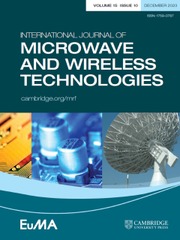No CrossRef data available.
Miniaturized multiband dipole-loaded C-shaped resonating patch linear–circular and linear-cross angular stable reflective polarization converter
Published online by Cambridge University Press: 25 July 2025
Abstract
An highly miniaturized multiband polarizer for C to Ka-band applications is proposed. The polarizer design consists of resonating patch printed on top of the FR-4 grounded substrate. During reflection, the x/y polarized incident EM wave becomes circularly polarized with Axial Ratio (AR ≤ 3 dB) from 7.88 to 8.01 GHz, 9.01 to 11.65 GHz, 15.36 to 36.57 GHz, and 31.88 to 35.38 GHz, respectively. In addition, this design also demonstrates linear–cross conversion with a minimum 90% Polarization Conversion Ratio (PCR) from 8.28 to 8.60 GHz, 12.56 to 14.19 GHz, and 28.26 to 30.59 GHz. Transfer Matrix Method (TMM) explains the polarization conversion phenomena, and surface current distribution at resonant frequencies supports the multi-polarization conversion phenomena. The proposed design is compact with a periodicity of 0.063λL × 0.076 λL, where λL is the free-space wavelength corresponding to the lowest operating frequency. The fabricated prototype is verified experimentally. The authors believe that the features of the proposed design, like multiband, miniaturized unit cell architecture, and better angular stability, make it a promising contender for satellite applications.
Information
- Type
- Research Paper
- Information
- International Journal of Microwave and Wireless Technologies , Volume 17 , Issue 4 , May 2025 , pp. 620 - 628
- Copyright
- © The Author(s), 2025. Published by Cambridge University Press in association with The European Microwave Association.


